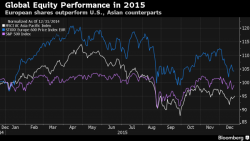With memories of last week's high-volume, post-Fed, quad-witching selloff fading fast, overnight the Santa rally defined as no volume, no breadth levitation, has continued for a third day and moments ago European stocks rose to their best level of the day, with the Stoxx Europe 600 Index headed for its biggest advance in a week, while US equity futures ramped on the European open as they traditionally do, and then again hit session highs minutes ago, as holiday volumes are in meltdown mode, and oddlots can move the E-mini by 1 point.
